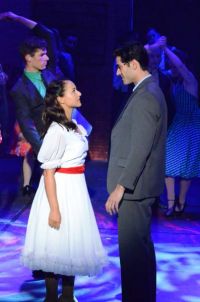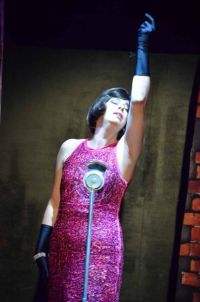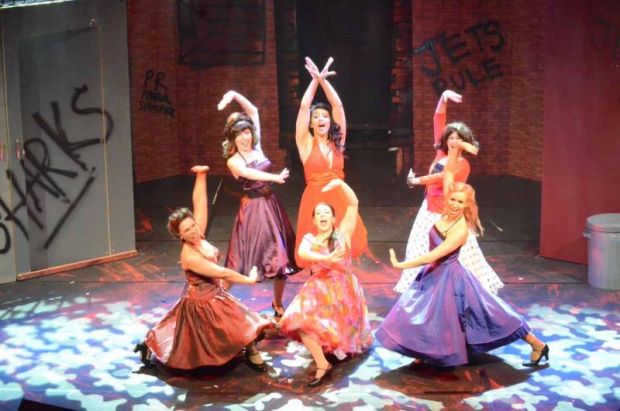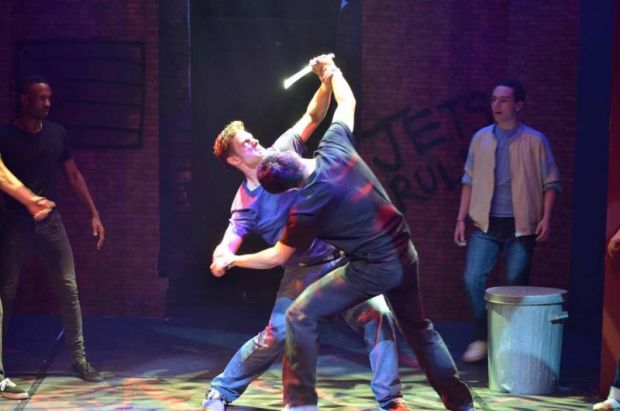West Side Story
Chatswood’s West Side Story works as well as it does because its latter-day ‘Romeo and Juliet’ love story matters, tugging at our heart-strings from the romantically heightened, danger-charged instant when star crossed lovers Tony and Maria lock eyes (and hearts) at the dance in the gym.
That success is due in no small part to a to-die-for Maria in Michaela Leisk, who matches a gorgeous soprano voice, and the perfect look for the role, with truthful dramatically charged intensity. There’s a credible chemistry with her Tony, Anthony Levin, while his beautifully staged death scene packs a powerful emotional punch.
 Michaela sparks delightfully off Susanna Downes’ feisty, engaging Anita, peaking in their intense duet, ‘A Boy Like That’, while Susanna also leads a snappy, energetic rendition of ‘America’. Michaela also displays sassy comic flair, especially when working with the Jets’ girls in a bright, lively version of ‘I Feel Pretty’.
Michaela sparks delightfully off Susanna Downes’ feisty, engaging Anita, peaking in their intense duet, ‘A Boy Like That’, while Susanna also leads a snappy, energetic rendition of ‘America’. Michaela also displays sassy comic flair, especially when working with the Jets’ girls in a bright, lively version of ‘I Feel Pretty’.
Anthony Levin is convincing and credibly earnest as Tony, though vocally he opts for falsetto in higher notes, with inconsistencies of tone in parts of his range.
 The Zenith’s small stage isn’t exactly conducive to the expansive gang choreography usually associated with West Side Story, so whether it was this, or the difficulty in finding male dancers in community theatre, the antagonism between the two gangs is achieved more through attitude than dance. Still, the male ensemble members play that pent-up anger and antagonistic race-based gang aggression effectively.
The Zenith’s small stage isn’t exactly conducive to the expansive gang choreography usually associated with West Side Story, so whether it was this, or the difficulty in finding male dancers in community theatre, the antagonism between the two gangs is achieved more through attitude than dance. Still, the male ensemble members play that pent-up anger and antagonistic race-based gang aggression effectively.
If you’ve only seen the film, the restricted dancing may seem like a link is missing in the show’s DNA, but I’ve seen enough versions where community theatre men and schoolboys weren’t up to the dancing demands to regard this sort of compromise as far preferable, even if I do miss the sheer exhilaration of the iconic choreography.
 It was in smaller numbers, particularly ‘Gee, Officer Krupke’, with it’s great attention to storytelling, where choreographer Stephanie Edmonds really got to show her skills with the boys.
It was in smaller numbers, particularly ‘Gee, Officer Krupke’, with it’s great attention to storytelling, where choreographer Stephanie Edmonds really got to show her skills with the boys.
Director Chapin Ayres’ original touches include an interesting rethink on the Act 2 dream sequence, setting this alternate world of this moment in the show, where Tony and Maria dream fleetingly of a having a future, in a bar, complete with a bar singer in a sequined dress (Lisa Cooper singing ‘Somewhere’ magnificently), before the dream disintegrates into a brawl.
 Isacc Bradley (Bernardo) and Jon Goodsell (Riff) lead their respective gangs credibly, with the gang members and their girls generally establishing believable individual characters, and attacking the show with great energy. James Jonathon’s brooding Chino, and Melody Ha’s cheeky Anybodys have most to do in the supporting gang roles, and do it well.
Isacc Bradley (Bernardo) and Jon Goodsell (Riff) lead their respective gangs credibly, with the gang members and their girls generally establishing believable individual characters, and attacking the show with great energy. James Jonathon’s brooding Chino, and Melody Ha’s cheeky Anybodys have most to do in the supporting gang roles, and do it well.
The adult roles are in capable, experienced hands, with Andy Davis an appropriately ugly character as the detective Shrank, while James Worner is a sympathetic Doc.
The production is perhaps a fraction overbuilt for this small stage, when dancing space is at a premium, leading to moments when props made various locations feel a little overcrowded. This made some scene changes drag on opening night, and there were the odd technical glitches, though I am sure backstage forces will be marshaled as the season progresses to ensure fluidity.
James Worner provides bright, attractive costumes for the female cast, providing flashes of colour in the bleak teen gangland of New York’s West Side.
As the short second act races toward its tragic conclusion, with the ill-fated lovers desperately clinging to their dreams, this West Side Story really hits its straps.
Neil Litchfield
Photography: Scott Clare.




Subscribe to our E-Newsletter, buy our latest print edition or find a Performing Arts book at Book Nook.

